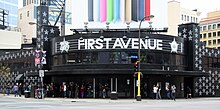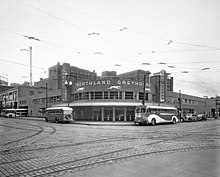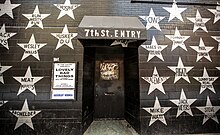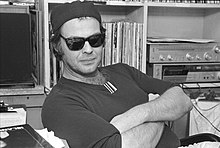First Avenue (nightclub)
The Mainroom and The Entry | |
 First Avenue nightclub in Minneapolis | |
 | |
| Former names | Greyhound Bus Depot (1937–1968) The Depot (1970–1972) Uncle Sam's (1972–1979) Sam's (1979–1981) |
|---|---|
| Address | 701 First Avenue North |
| Location | Minneapolis, Minnesota 55403 |
| Coordinates | 44°58′41″N 93°16′33″W / 44.97800°N 93.27594°WCoordinates: 44°58′41″N 93°16′33″W / 44.97800°N 93.27594°W |
| Genre(s) | music, concerts |
| Capacity | 1,550 (Main Room) 250 (7th St Entry) |
| Construction | |
| Built | 1937 |
| Opened | April 3, 1970 |
| Website | |
| www | |
First Avenue & 7th St Entry (locally known as The Mainroom and The Entry) are two music venues housed in the same landmark building in downtown Minneapolis, Minnesota. The names are derived from the building's location on the corner of First Avenue North and 7th Street North. The building is marked by 531 stars on its exterior commemorating past venue performers.[1]
David Carr wrote in The New York Times that First Avenue's cultural weight and history is matched by only a few clubs in the United States: CBGB, Maxwell's, Metro Chicago and the 9:30 Club.[2]
The nightclub celebrated its 50th anniversary in 2020.
Facility, opening[]


The building opened as a bus depot in 1937, decades after Greyhound Lines was founded in Hibbing, Minnesota. It was noted for its Art Deco style and amenities of air conditioning, shower rooms, and public telephones. The interior floor was checkered terrazzo, while the exterior was shiny blue bricks with white trim.[3] The bus station moved to its present location on 10th Street in 1968.[4]
The transformation from a bus depot into a concert venue has a disputed history.[4] Clearly, Allan Fingerhut, heir to the Fingerhut catalog company, had capital and invested $150,000, and Danny Stevens of Danny's Reasons had a hard-to-get liquor license.[4] Both men agree promoter Skip Goucher had the original idea for a nightclub in the bus depot.[4]
They opened The Depot on April 3, 1970, with Joe Cocker and a stage crowded with 27 musicians and singers who turned in two magnificent sets.[4] Among Cocker's Mad Dogs & Englishmen that day were Leon Russell, Rita Coolidge, Claudia Lennear, Jim Keltner, Jim Price and Bobby Keys.[5]
Disco era[]
Following two years of steady business, The Depot was faced with a new reality: the public music scene was changing. Psychedelic rock was out and disco was in. In order to stay on top of this new trend, the club needed to change its image. After a short remodel, The Depot in July 1972, evolved into Uncle Sam's, a national franchise of the American Avents Corporation of Cincinnati. A red, white, and blue patriotic-themed club with recorded dance music, a drummer, a DJ, and a light-up plexiglass dance floor became what doorman Richard Luka described as, "Studio 54 for the discriminating Kmart shopper."[6] In about late 1973, Steve McClellan (who'd become the club's talent buyer and eventually general manager)[7] started working at Uncle Sam's as a bartender.[8] He would enter American Avents' management training in 1975.
After American Avents left in 1979, general manager Steve McClellan hired his former high school classmate Jack Meyers to help him manage money.[8] Dan Lessard managed the bar staff. The club's name was shortened to Sam's in early 1980. The club got its third name change on New Year's Eve 1981 when it became First Avenue.[9]
7th St Entry[]

The 7th St Entry is a smaller stage (capacity 250) attached to the historic First Avenue (capacity 1500).[10] This space was once a restaurant (the "Greyhound Cafe") and later a coatroom, before staffer Danny Flies and McClellan spent $1,500 to turn it into a barebones music venue as part of Sam's. Meyers donated his own Bose speakers for stage monitors.[11] Like Jay's Longhorn Bar and Duffy's, the Entry catered to local bands, often too new to play the Mainroom.[9][12]
The Entry opened its doors on March 21, 1980, with Cathy Mason fronting Wilma & the Wilburs, who were first to play, as warmup for headliner Curtiss A.[11]
Danceteria[]
Chrissie Dunlap began to work days in the office in 1979, about the time McClellan booked the Ramones and Pat Benatar in back-to-back, sell out concerts. Disc jockeys Kevin Cole and Roy Freedom developed weekend dance nights dubbed Danceteria inspired by the New York club of that name, often creating enough business to pay the club's bills. The club has, through much of its existence, survived on the success of its dance nights.[13]

The Prince explosion[]
Discrimination had created a race barrier in downtown Minneapolis. Encouraged by Dunlap to write their own material,[15] Jimmy Jam and the 11-piece Mind & Matter were able to break through with bookings by McClellan in the 1970s. First booking blacks in the one-hit wonder Lipps, Inc., with lead singer Cynthia Johnson, McClellan decided to book Prince in 1981, for $2,500 plus part of the gate. Before he died in 2016, Prince was to play nine full First Avenue concerts. Over time, many of his fans thought he owned the club.[15]
Recorded live in 1983 from a Record Plant truck parked outside at one of those shows, "Purple Rain" became the title of the film Purple Rain. Prince's management team offered First Avenue $100,000 to use the mainroom for filming in late November and December 1983, with the clause that the Entry would remain open. Most of the club's employees were extras in the film. The production gave the club its patch panel and dimmer packs. McClellan feared the audience had changed from genuine music lovers to a lot of tourists, still, he and Meyers were grateful for the boost in revenue.[15]
Changes in ownership[]
The club was briefly closed by Fingerhut in late fall 2004 for financial reasons, causing a wave of protest from music fans.[2] The issues were quickly resolved (the judge presiding in the bankruptcy case noted, "I gather there is some urgency about this"), and the club was reopened by new partners Meyers, McClellan, and former business manager Byron Frank, with shows resuming after one week's closure.[2] An experienced crowd surfer, Minneapolis mayor R.T. Rybak reneged on his promise to stage dive at the first show after reopening.[16]
McClellan ended his 32-year stint at First Avenue in 2005,[17] and began to focus on local music non-profit, the Diverse Emerging Music Organization (or DEMO).[18] After McClellan's departure as general manager, Jack Meyers was appointed to the position and continued until 2009, when Nathan Kranz took over.[19] Dayna Frank took over for her father the same year.[20]
Notable events[]
The nightclub has been the starting point for many bands that have come out of the Twin Cities, including Prince, The Revolution, The Replacements, Hüsker Dü, Soul Asylum, Semisonic, Atmosphere, Brother Ali, Dosh, The Jayhawks, Mint Condition and Curtiss A, among others.[citation needed]

Bands and artists have performed at the nightclub and influenced the Minneapolis music scene from 1970 onward, as exemplified by the silver stars that adorn the black building's exterior (every star has the name of an artist who has played at First Avenue or 7th St Entry). First Avenue also appeared in Prince's 1984 film Purple Rain,[21] and many of the film's music performances take place at the venue.[22]
U2 wrote part of October at First Avenue, during sound check.[23]
Grammy Award-winning alternative-country star Lucinda Williams was married on stage following a performance at First Avenue in 2009.[24]
Gwar guitarist Cory Smoot played his last performance at the venue on November 3, 2011—he died just hours afterward.[25]
The club was named in Playboy Magazine's Guide to Best Nightclubs in the World at #15 out of 20 in the November 2013 issue.
During the Theory of a Deadman concert on August 12, 2015, part of the ceiling collapsed, pulling down part of the sprinkler pipes. Three people were slightly injured, two of whom were taken to the hospital.[26][27]
The non-profit Developing Music and Arts Foundation (DMAF) was founded by the club in 1999. It was rechristened The Diverse Emerging Music Organization (DEMO) in 2004 as an independent entity.
Productions[]
In 1970, The Depot recorded the first live album from the venue, titled Gathering at The Depot, featuring artists such as Danny’s Reasons and The Litter.[28]
Daniel Corrigan is a First Avenue photographer since 1981 whose work fills the book Heyday.[29] Later after the advent of ubiquitous digital photography, he became an employee in the facilities department,[30] and made a series of under-two minute videos for the Minnesota Historical Society describing his photos.[31]
First Avenue & 7th St Entry published a promotional book in 2000, First Avenue & 7th Street Entry: Your Downtown 'Danceteria' Since 1970. The book was written, edited and designed by Rebecca Noran; and contains information on the history of the club.[9] Furthermore, the club published a magazine entitled First Avenue In House for a brief time from September 1998 to August 2000.[32][33]
In November 2005, First Avenue released its first compilation CD celebrating 35 years of history. The 16 track CD, Bootlegs Volume 1, is a collection of songs recorded in either the mainroom or the 7th St Entry. Most of the songs on the CD were bootlegged, thus forming the title of the CD.[34] Bootlegs was produced by Karrie Vrabel, with the liner notes written by Steve McClellan.[35] All the proceeds of the CD go to McClellan's non-profit organization, DEMO.[36] The goals of his organization are "to support musicians while promoting gender equity; diversity of music style and genre; diversity of musicians from local communities; careers in all stages of establishment; and the staging of performances with high production values."[37]
First Avenue is also home to F1RST Wrestling, a local professional wrestling company currently owned by professional wrestler Arik Cannon. It showcases Minnesota's top wrestling talent and brings in bigger names, including Sean Waltman, Jerry Lynn, Tyler Black, Colt Cabana and others. F1RST Wrestling currently holds its WRESTLEPALOOZA events at First Avenue which feature a combination of pro wrestling, live music and burlesque.
References[]
- ^ Entertainment: First Avenue; January 17, 2008 article; Minneapolis Star Tribune; retrieved February 05, 2013.
- ^ Jump up to: a b c Carr, David (November 15, 2004). "First Avenue Is Dead (Long Live First Avenue!)". The New York Times. Retrieved May 10, 2020.
- ^ First Avenue History; First Ave on-line.
- ^ Jump up to: a b c d e Riemenschneider, pp. 13–21.
- ^ The Depot Grand Opening. Facebook. April 3, 2020. Retrieved Aug 13, 2020.
- ^ Riemenschneider, p. 48–49.
- ^ Bream, Jon (March 22, 2015). "Mayors declare Steve McClellan Day today in Mpls. and St. Paul". Star Tribune. Retrieved August 12, 2019.
- ^ Jump up to: a b Johnson, Cecilia. "The Current Rewind: Nov. 28-29, 1979". www.thecurrent.org. Retrieved 2020-11-03.
- ^ Jump up to: a b c Noran, Rebecca (2000). First Avenue & 7th Street Entry: Your Downtown 'Danceteria' Since 1970. Minneapolis: First Avenue & 7th Street Entry. pp. 15–20.
- ^ Music: 7th St Entry; Minneapolis Star Tribune article; retrieved .
- ^ Jump up to: a b Riemenschneider, pp. 66–71.
- ^ MNHS.ORG.
- ^ Riemenschneider, p. 65, 71, 75.
- ^ Gensler, Andy (January 16, 2020). "High Road's Frank Riley: On Creating A 'Beacon For Working Musicians'". Pollstar. Retrieved January 28, 2020.
- ^ Jump up to: a b c Matos, Michaelangelo (March 14, 2016). "Everybody Is a Star: How the Rock Club First Avenue Made Minneapolis the Center of Music in the '80s". Pitchfork (Condé Nast). Retrieved August 12, 2019.
- ^ David (July 18, 2004). "Mayor RT Rybak Stage Dives and Crowd Surfs at First Avenue during Rock for Democracy". HowWasTheShow Blog. Retrieved April 11, 2012.
- ^ "The First Avenue Massacre - What Steve McClellan's Pink Slip Said"; by Jim Walsh; City Pages article.
- ^ Diverse Emerging Music Organization; organizational website.
- ^ "About Us: History: Current". First Avenue, 701 Ventures. Archived from the original on March 24, 2010. Retrieved January 18, 2010.
- ^ Riemenschneider, p. 10.
- ^ [permanent dead link] Purple Rain; at Fast Rewind.
- ^ Top 10 Cities That Need Statues from '80s Movies: Minneapolis (Purple Rain); TIME article.
- ^ Keller, Martin (August 4, 1999). "Young Spuds in a Longhorn Daze". City Pages. Village Voice Media. p. 2. Archived from the original on December 24, 2009. Retrieved 2009-11-16.
- ^ "Wedding bells at First Ave".
- ^ Riemenschneider, Chris (November 4, 2011). "Guitarist dies after GWAR plays First Ave". Star Tribune. Retrieved 2011-11-04.
- ^ Jay Knoll (August 12, 2015). "First Avenue evacuated after ceiling collapse, injuries reported". KARE 11. Retrieved August 13, 2015.
- ^ Phil Helsel, Shamar Walters (August 12, 2015). "First Avenue Ceiling Collapses During Theory of a Deadman Show in Minneapolis". NBC News. Retrieved August 13, 2015.
- ^ "Gathering at the Depot". Discogs. Retrieved May 9, 2020.
- ^ Thompson, Erik (October 26, 2016). "Daniel Corrigan's 'Heyday' gorgeously reveals 35 years of Twin Cities music photography". City Pages. Retrieved May 10, 2020.
- ^ "Dan Corrigan". MN Original (MNO): Twin Cities Public Television. Retrieved May 10, 2020.
- ^ Dan Corrigan. "Storied: Heyday, Prince"., "Storied: Heyday, The Replacements"., "Storied: Heyday, Hüsker Dü"., "Storied: Heyday, Henry Rollins"., "Storied: Heyday, The Whole Lotta Loves"., "Storied: Heyday, Babes in Toyland"., "Storied: Heyday, Iggy Pop"., "Storied: Heyday, The Suburbs". Minnesota Historical Society. Retrieved May 10, 2020 – via YouTube.
- ^ "A small collection of 85 magazines, 43 poster/calendars, 13 Danceteria Tickets, & more". Rulon-Miller Books. Retrieved May 7, 2020.
- ^ "First Avenue website". Archived from the original on 2009-11-21. Retrieved 2009-11-16.
- ^ "Music" Archived 2011-06-07 at the Wayback Machine. Minneapolis Star Tribune article.
- ^ Features: First Ave; Minnesota PBS
- ^ First Avenue 'Bootlegs,' vol. 1[permanent dead link]; First Avenue website.
- ^ DEMO Blog.
Bibliography[]
- Riemenschneider, Chris (October 15, 2017). First Avenue: Minnesota's Mainroom. Minnesota Historical Society Press. ISBN 9781681340449.
Further reading[]
- Keller, Martin (2019). Hijinx and Hearsay: Scenester Stories from Minnesota's Pop Life. Minnesota Historical Society Press. ISBN 9781681341323.
- Corrigan, Daniel (photos); Sigelman, Danny (text) (2018). Heyday: 35 Years of Music in Minneapolis. Minnesota Historical Society Press. ISBN 978-1681341231.
- Johnson, Cecilia (2020). "The Current Rewind: 10 Pivotal Days at First Avenue." The Current (KCMP) (Podcast). Retrieved 2 November 2020.
- Matos, Michelangelo (March 14, 2016). "Everybody Is a Star: How the Rock Club First Avenue Made Minneapolis the Center of Music in the '80s". Pitchfork.
- Riemenschneider, Chris (2016). "Prince and First Avenue: a history of the club's ties to its brightest star". Star Tribune.
- Riemenschneider, Chris (January 17, 2008). "A day in the life of First Avenue". Star Tribune.
- Scholtes, Peter S. (November 3, 2004). "First Avenue's Black Tuesday". City Pages. Archived from the original on January 19, 2013 – via Archive Today.
External links[]
| Wikimedia Commons has media related to First Avenue and 7th Street Entry. |
- Official website
- Joe Cocker performing "The Letter" at The Depot's 1970 grand opening, 6:40 minutes
- First Avenue: Closer to the Stars (March 30, 2020). Twin Cities PBS (TPT), 57 minutes
- Nightclubs in the United States
- Culture of Minneapolis
- 1970 establishments in Minnesota
- Music venues in Minnesota
- Greyhound Lines
- Art Deco architecture in Minnesota
- Tourist attractions in Minneapolis
